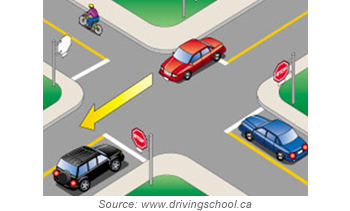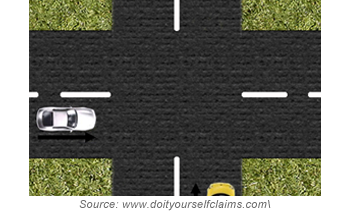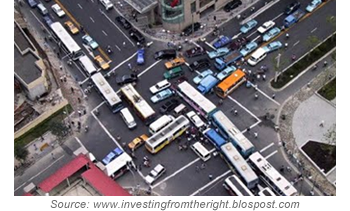Driving through intersections is one of the most complex driving situations a motorist will encounter. According to the Federal Highway Administration, intersection collisions account for more than 40% of all reported crashes and 21% of fatalities. As a result, it is important that drivers approach intersections with caution, carefully observing the laws that govern their usage.
The California Drivers Handbook defines an intersection as any place where one line of roadway meets another roadway. Intersections include cross streets, alleys, freeway entrances, and any other locations where vehicles travelling on different highways or roads join each other. There are two types of intersections, controlled and uncontrolled.
A controlled intersection is one that is controlled by street signs, such as stop signs and yield signs. They can also be controlled by traffic signals.

An uncontrolled intersection doesn’t have signs or signals to assist you in determining who has the right-of-way. You must know the appropriate rules to decide who must yield to whom. We will discuss these rules in this section.
11.2.1 Right-of-Way
Right-of-way rules designate who shall yield when there is a potential conflict between vehicles or between a vehicle and a pedestrian. In general, right-of-way rules require one person to yield and stop, and to let another proceed first. It is extremely important that drivers know and obey the right-of-way laws. Not knowing or disobeying these laws can lead to serious collisions.
Uncontrolled Intersections
At an intersection without “Stop” or “Yield” signs, you must slow down and be prepared to stop. Yield the right-of-way to pedestrians, bicyclists, and/or traffic already in the in the intersection, or who are just entering. If you meet at an intersection with another vehicle or bicyclist at the same time, the vehicle to your right has the right-of-way.

If you are at a “T” intersection without a “Stop” or “Yield” sign, the traffic on the through road has the right-of-way.
If you need to make a legal left turn or a U-turn, yield the right-of-way to approaching traffic that is close enough to be dangerous. Be aware of vulnerable roadway users such as motorcycles, bicyclists, and pedestrians who may be crossing the road, before making your turn.
11.2.2 At Intersections When Signal is Out
If the traffic signal light is not working, proceed cautiously, acting as if “STOP” signs in all directions control the intersection.
11.2.3 Anti-Gridlock Law
The California Vehicle Code has established regulations for the passage of a motor vehicle through a crosswalk or railway crossing. These regulations exist so that the motor vehicle does not block the intersection and create grid-lock.

- A driver may not enter an intersection or marked crosswalk unless there is enough space on either side of the intersection or crosswalk for the vehicle to pass through, without blocking the passage of vehicles from either side.
- If a driver is making a turn at an intersection that is facing a yellow light or yellow arrow signal, they may not enter the intersection or marked crosswalk unless there is enough space on the other side of the intersection or crosswalk for the vehicle to pass through, without blocking the passage of vehicles from either side.
- A driver may not enter a railroad crossing, unless there is enough space to clear the intersection without blocking the passage of a railway vehicle, such as a train, trolley, or city transit vehicle.
- A driver may not enter a railroad crossing unless there is enough space on the other side of the railroad or transit crossing to accommodate the vehicle and any railway vehicle, such as a train, trolley, or city transit vehicle. (CVC 22526)



